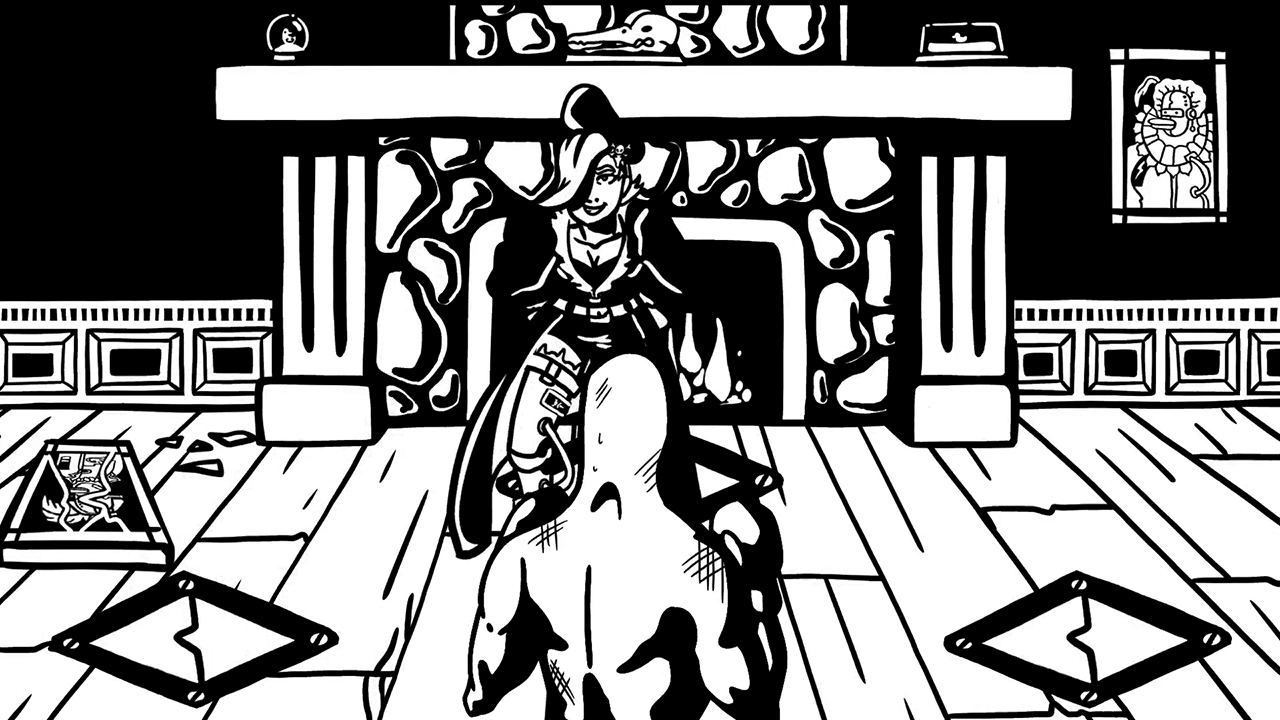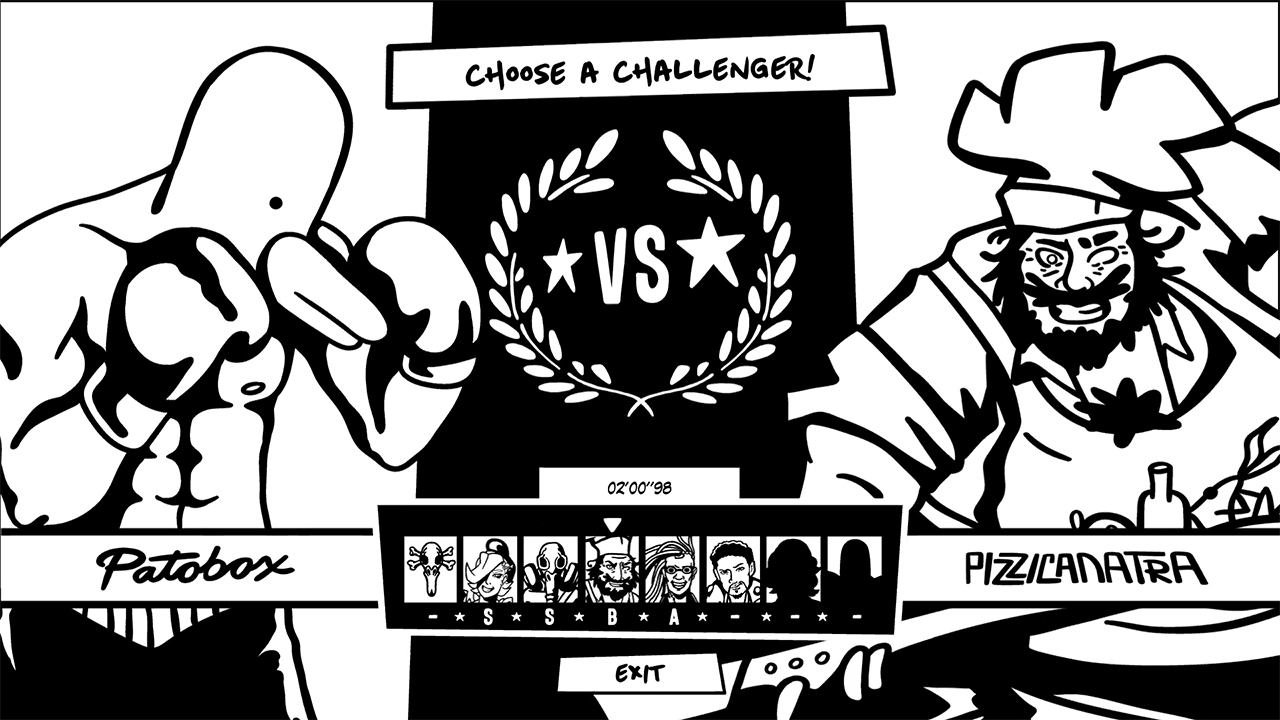[Review] Pato Box
System: Switch (eShop)
Release date: July 9, 2018
Developer: Bromio
Publisher: Bromio
Pato Box is one of the weirdest games I’ve played in recent memory. On the surface, it almost looks like it has some sort of fusion between Punch Out!! and Sin City sprinkled with Hotline Miami, but once the game begins and gameplay actually starts, you begin to notice a shift in tone, progression, and even genre going from section to section. It’s a unique experience that may not be for everyone, but should be commended for blending tons of styles and creating something as goofy as it is intriguing.
In Pato Box, you’ll be playing as a former boxing champion who happens to be part duck. After what seems like a botched fight and attempted assassination, you’ll be forced to come back and fight through the ranks to find those responsible in an evil organization called Deathflock looking to corrupt and rig people and fights to their favor. They have a much bigger scheme internally, and it’s up to you to bring an end to them all. The story is a basic revenge story and one of “never backing down” similar to the likes of Rocky, but it’s the design of the entire game that stands out and makes it captivating in an odd way.
Outside of its aesthetic, Pato Box quickly makes it known that it is not just a fighting game. In fact, it shouldn’t be seen as a fighting game at all, and instead of more of a puzzle adventure title that happens to have combat during its boss fights at the end of every stage. There aren’t any enemies outside of the bosses, so the majority of your time will be spent navigating through traps and obstacles that each themed boss has set up, finding ways to unlock areas and doors to get deeper into each dungeon, floor, or layout before inevitably facing the boss at the end, each being their own type of fighter. The levels, much like the bosses, are unique and no two ever felt the same. Sometimes you’ll have a time-based level, others have very dangerous obstacles like poison gas or electricity that you’ll have to have quick thinking for when trying to overcome, among a slew of other traps and things for you to go up against. While some can get stupid difficult, dying or having to retry was reasonable since checkpoints occur relatively often, so it never felt tedious having to do things over again. Frustrating sometimes, sure, but that was because of the challenge and not because of mechanics that didn’t work or puzzles that were nonsensical – it’s all very much trial and error on the user’s end.
While you’ll be spending the bulk of your time in Pato Box in the building of Deathflock’s headquarters, it’s not a linear experience in that you’ll be going from floor to floor one after the other until you eventually reach the top where the Kingpin is. If anything, the structure very much reminded me of Mega Man where you’d select the area/boss you’d like to go to/fight and, much like Mega Man, have to go through a fairly difficult test of reactionary gameplay before putting your trials and tribulation to the test with the corresponding boss at the end.
The oddest thing to have to overcome at first is probably the tank controls that it has (yes, tank controls in 2018), but once that’s taken care of the rest is straightforward. The controls are easy to pick up, having a basic A/B is right jab and XY is left jab with the left stick is used for moving and dodging, but it is a hard game to master as the boss fights themselves are just as reactionary and time-based as the rest of the game.
Traversing each location, you’ll come across various collectibles, most of them being helpful information that deepen the lore of Pato Box and others help with informing on various weapons and deadly tactics that the fighter is known for so you have an idea of what you’ll be going up against. Howeve,r the only real useful collectible you’ll be running into are Patokens, and even then all they really do is spruce up your bedroom a bit, which serves as like a sort of safe zone.
The boss fights are meant to be tough, and with the controls being as simple as they are and no means to upgrade any stats whatsoever, it really does come down to memorizing patterns and using their own methods of fighting against them more so than any real technical skill. Some bosses will call on outside help such as turrets that you’ll have to dodge or punch quick enough to destroy, while others will hurl projectiles in your direction that you’ll again either have to dodge or punch at the right time and angle to send it back to them. Each boss has several phases that are indicated by a change in the environment, and once you’ve hit them enough you’ll eventually find yourself in the ring with them during the final bout. While each level has generous checkpoints, the boss fights themselves have none, so even after spending ten minutes in a fight and you finally manage to get to the final phase, if you get KO’d – and you will get KO’d – you’ll have to start the whole thing over again. It can get frustrating, but it is a rewarding experience once you manage to overcome and be victorious.
Once bosses are cleared, rooms for the corresponding boss will open that will grant you access, where you can then go in and discover extra goodies. The rooms aren’t too eventful, and, as like most collectibles in the game, mainly provide further insight into the mind and methods of the fighter you’ve just defeated. It’s almost seen as like a trophy room of sorts to imply that you’ve beaten them, and any doors that are closed are there to let you know that you’ve yet to complete their trial.
Outside of the main game itself, there’s not much to really offer. You’ll be walking around mostly dead areas with not much to interact with, and the replay value is very low. After you’re finished with the story content, you’re only really left with the Arcade Mode where you can face all the fighters and try to beat them in the quickest time possible. There’s also an option within Arcade Mode that’ll allow you to face all the fighters in one go, and if you get KO’d, you’ll have to start all the way back at the beginning. With not much depth within the controls, it starts to feel more like a rhythm game where you’ll have to best react to the tempo of the fight, but obviously without music. It can get tedious, and outside of the story I’m not sure why you’d want to go through all of that again. It would have been nice to be able to choose fighters afterwards and see what it’s like playing as those that you’ve faced, but you’ll still remain as Pato the entire time.
It’s hard to say where Pato Box fits in terms of demographic, as it infuses so much but also offers very little. It’s accessible but difficult, genre-bending but linear, classic but modern, eventful but anticlimactic, and broad but niche. It makes no sense, but I commend Pato Box for doing what it does and offering something new. It’s certainly not for everyone, and you don’t even have to like boxing or sports to appreciate Pato Box, but its wonky controls outside of battle and little to nothing to do post-game makes it a hard sell, and I’d argue some people would even be deterred by its purely black and white aesthetic. It wouldn’t be the first game to do this, but with very little but with very little in the way of inspiration for its art direction to begin with, it’s not a particularly pleasing game to look at either.
The Verdict
Pato Box is so out there and unique that, while it’s a good game, it is most definitely not going to be for everyone. The Sin City, Punch Out!!, and Hotline Miami amalgamation of Pato Box sounds like it’d hit a lot of the right notes for a lot of people, but there’s something about it that will require a certain patience, willingness, and devotion for it to actually click with players. If you’re looking for something unique and have the funds to spare, then absolutely give Pato Box a try, but keep an open mind as its unorthodox gameplay, progression, and lack of replay value could deter a decent amount of players from giving it proper recognition.
Pato Box review copy provided by Bromio for the purposes of this review.




